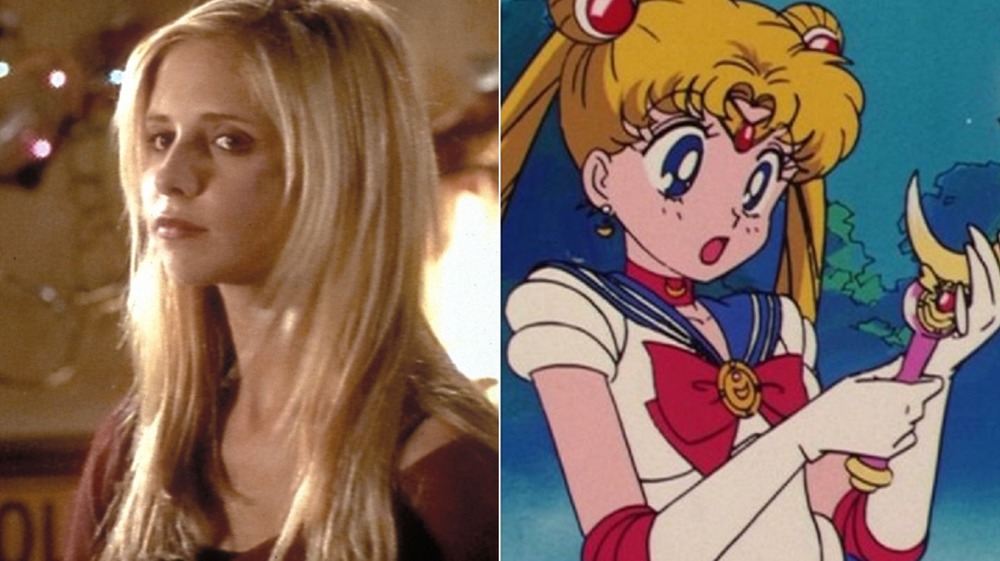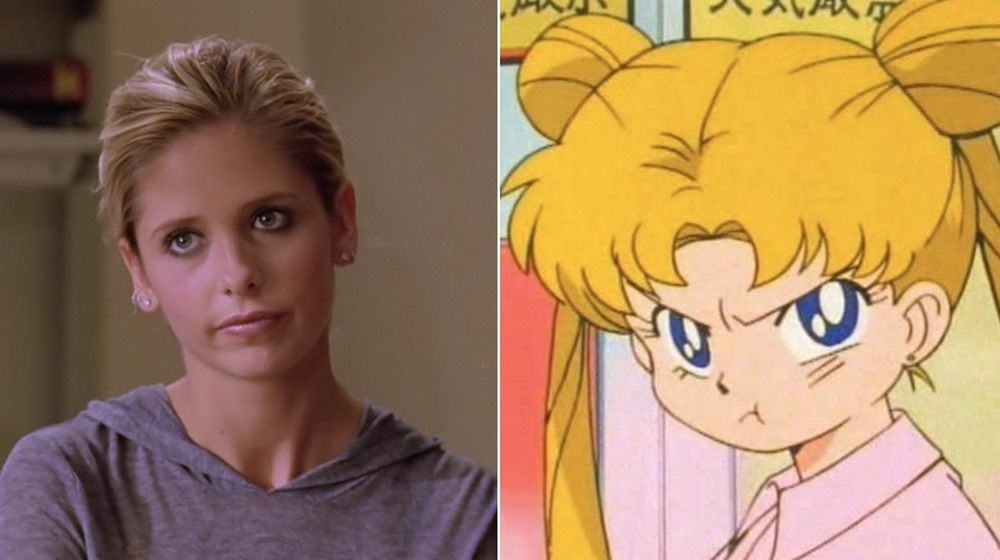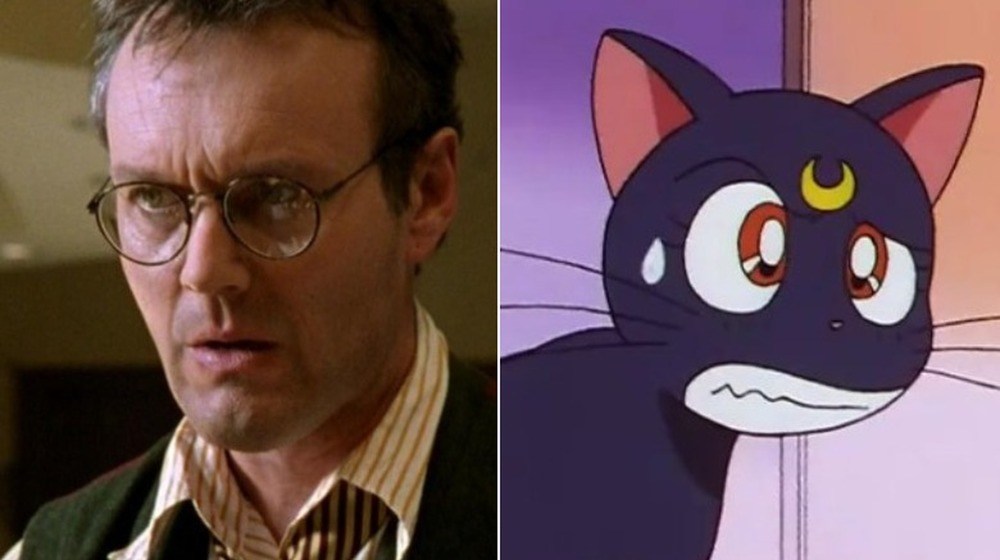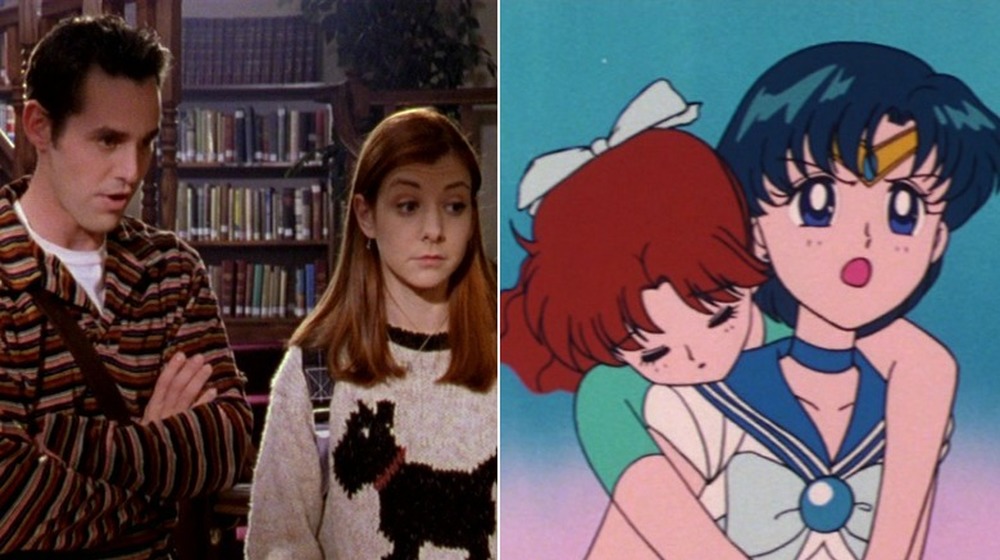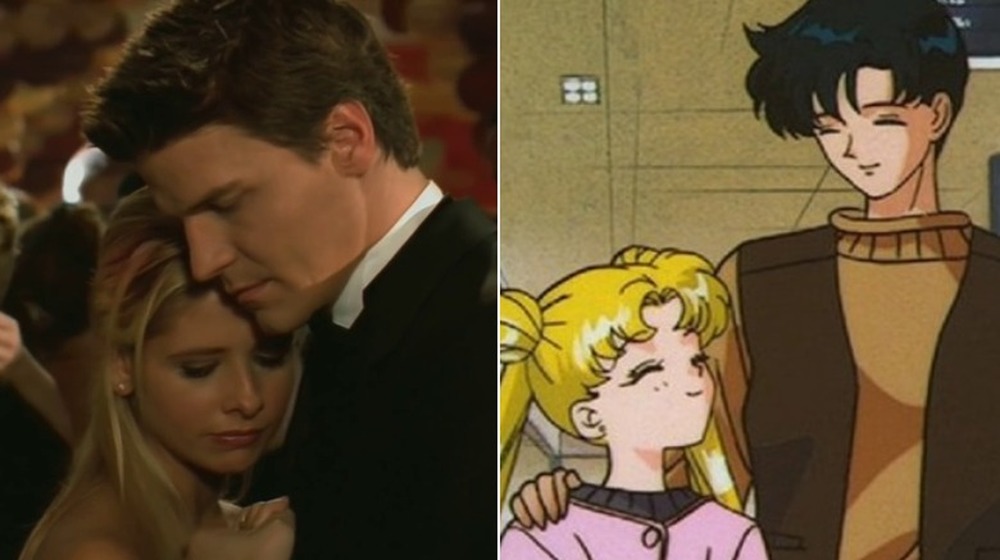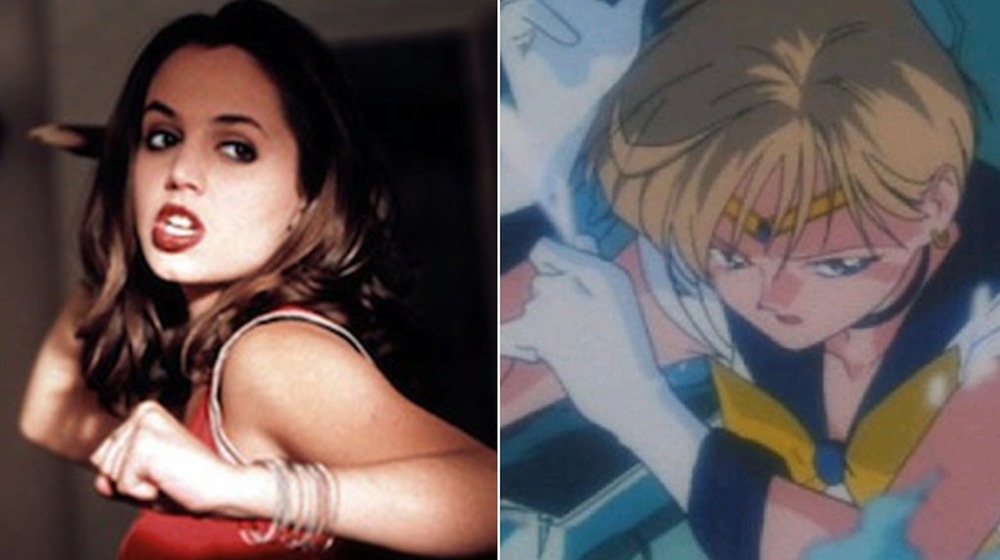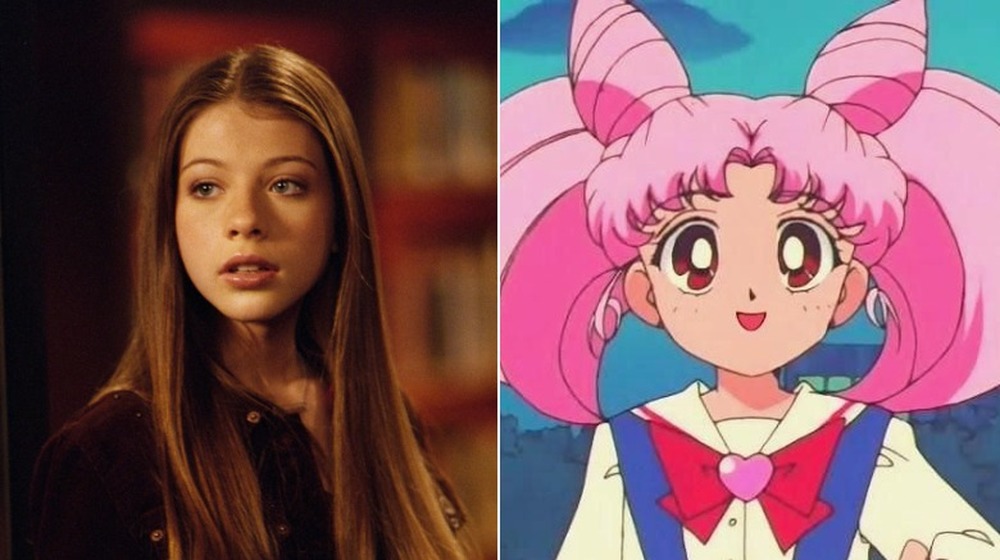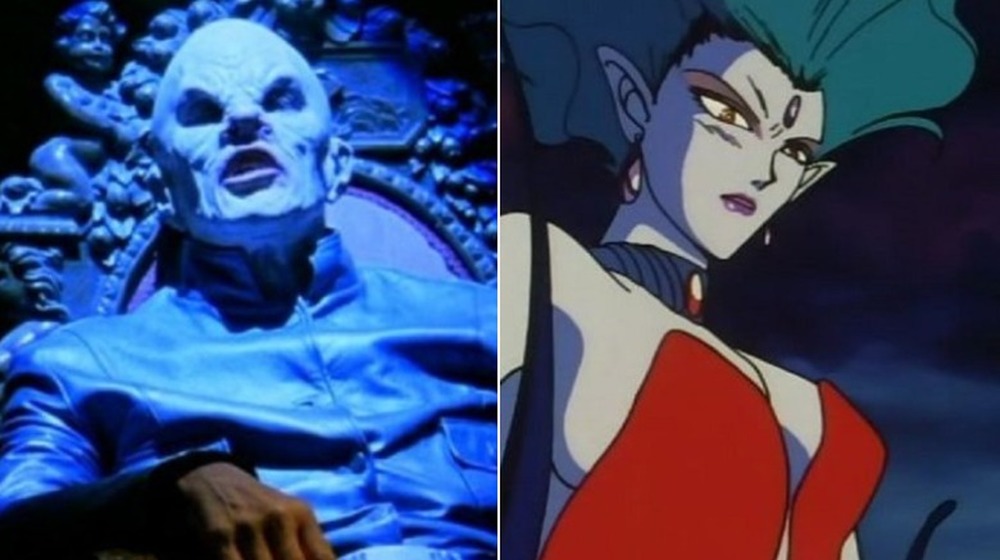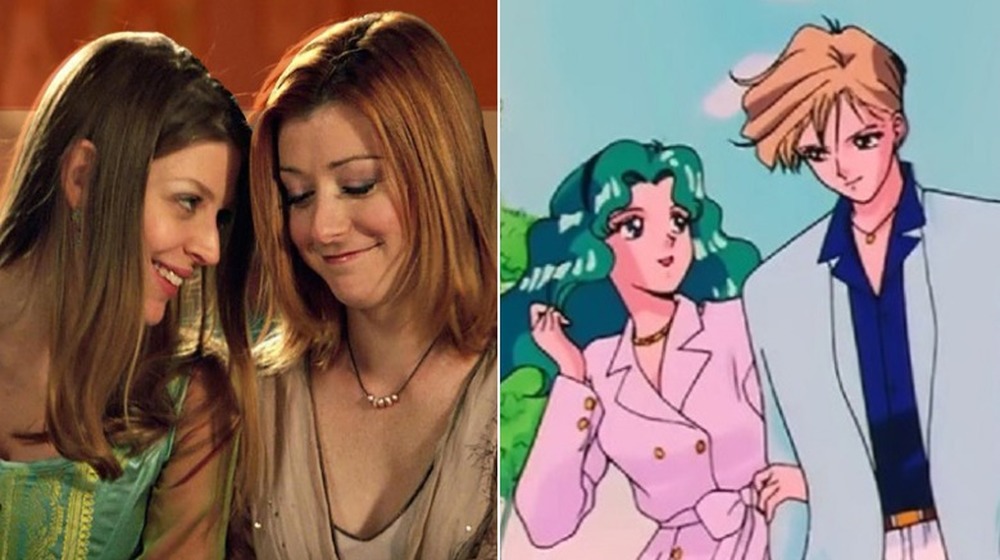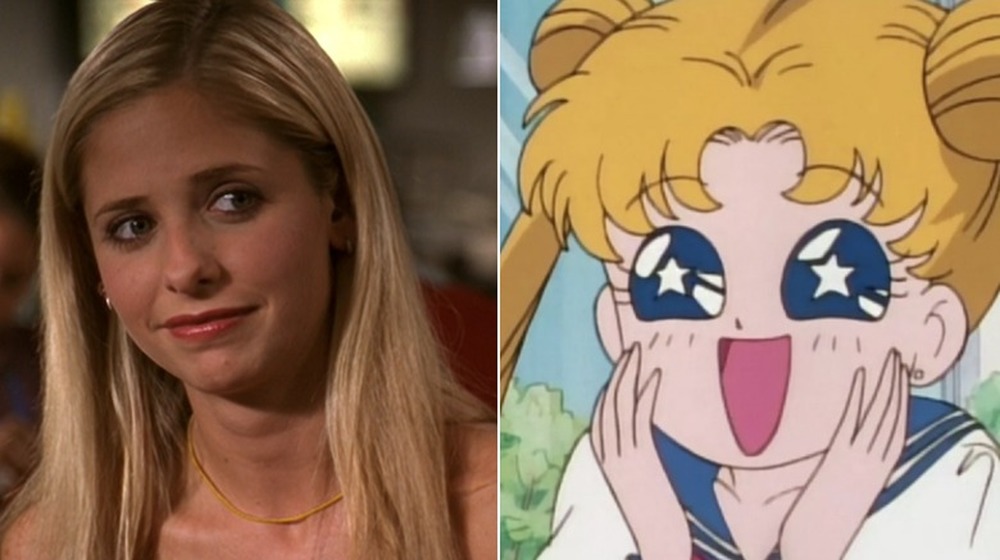Why Buffy The Vampire Slayer And Sailor Moon Are Really The Same Show
To each generation a slayer is born. One girl in all the world, a chosen one, a pretty guardian who fights for love and justice. Okay, we know this is a weird one, but stick with us. If you really think about it, Buffy the Vampire Slayer and Sailor Moon are really the same exact show.
Some stuff is obvious. We have a normal teenage girl with a big heart who's, according to an ancient prophecy, the only one who can save the world from an army of monsters that sustain themselves by draining the life force of ordinary humans. But if you dig deeper, it just keeps going. Most of the characters in one series — both major and minor — have a fairly direct analogue in the other. And throughout the entire run of both of these very long shows, many of the setting elements and plot beats continue to mirror each other in ways both eerie and hilarious.
Join us as we run down all the silly and surprising ways that we've recently realized that two of the most influential shows of the 1990s, series from opposite sides of the world, are actually just two versions of the same story with a different color palette, if you're willing to turn your head sideways and squint.
Buffy and Sailor Moon both feature an unlikely chosen one
Whether they're fighting evil by moonlight or winning love by daylight, the similarities between Sailor Moon and Buffy the Vampire Slayer start with our two titular heroines. Both begin as ordinary teenagers, a pair of shrimpy blondes who have reputations for being somewhat ditzy. Neither would be anyone's first choice to save the world.
Buffy Summers' life changes forever when she turns 15 and learns that she's the Slayer, the latest incarnation in a long line of similar chosen ones destined to stand against the creatures of the night. Using her newly found superhuman strength and speed, she alone is strong enough to oppose the darkness and slay the bloodsucking vampires that stalk the streets of Sunnydale, California.
Along similar lines, everything changes for Usagi Tsukino at 14 years old, when she learns that she's the reincarnation of a great hero from the past, the "pretty guardian of love and justice" known as Sailor Moon. Through the aid of a magic brooch, she learns how to transform into this previous version of herself, becoming a magical superhero with the ability to vanquish the strange, energy-draining monsters that threaten the Juban district of Tokyo.
Understandably, both girls initially reject their respective magical destinies. Surely, they can't be superheroes. Couldn't the mysterious magical forces of destiny choose someone else? However, over the course of many years and many seasons of heroic adventures, both of these "dumb blondes" manage to save the world multiple times over and prove everyone wrong who underestimated them, especially themselves.
Both heroes have a wise mentor with an English accent
What would a monster-slaying hero be without a wise mentor figure to guide them? For Buffy, this comes in the form of Giles, Sunnydale High School's unassuming librarian. Shortly after moving to Sunnydale, Buffy learns that her school's soft-spoken Englishman is actually a member of a secret society known as the Watchers, a group of scholars and warriors tasked with studying and fighting the forces of darkness and with seeking out Slayers in order to train them. In their first meeting, Giles instantly recognizes who Buffy is and presents her with a gift, a heavy tome with the word "vampyr" on the cover.
As for Usagi, she ends up with Luna. Granted, Luna looks quite different from Giles on the outside — being a tiny talking black cat with a yellow moon on her forehead — but on the inside, she serves a near-identical role, being an anxious and stuffy straight man to our hero's antics. And her first conversation with Usagi is quite similar to Giles'. Luna also presents her young ward with a gift, a golden brooch that allows Usagi to transform into Sailor Moon.
As a side note, arguably the most important similarity between these two characters is that both of them speak with English accents. To be fair, this isn't always the case. Luna only has her posh English accent in the original '90s dub and not in the later dub or in Sailor Moon Crystal. But given that the old dub was the first version of Sailor Moon to arrive in the Western world, the distinguished British nanny Luna stuck with many English-speaking viewers as their definitive version of the character.
Both shows have the normal friend, the smart friend, and the mean brunette friend
Though they don't all line up perfectly, there are a surprising amount of similarities between Buffy's friend group — the Scoobies — and Sailor Moon's various teammates and classmates.
First up, we have the normal friend. In Buffy, this is Xander, a nerdy boy next door who does his best to help in the fight against evil ... with mixed results. In Sailor Moon, this is Naru, Usagi's cheerful best friend who has a habit of getting kidnapped by monsters. Also, though Xander and Naru aren't themselves supernatural, strangely enough, both characters eventually end up romantically entangled with someone who is, both former antagonists no less (Anya and Nephrite, respectively).
Next, we have the smart friend. Buffy has Willow, a shy nerd who eventually shifts her massive intellect away from studying computers and towards studying witchcraft. Usagi has Ami, a similarly introverted bookworm who also ends up with magical powers when she becomes Sailor Mercury. This is one of the cleanest matches of all. They're basically the same character.
And now we have the final friend, if you can even call her that — the mean brunette. Though ostensibly our hero's ally, the mean brunette actually spends most of her time insulting our perky blonde protagonist. For Buffy, this is Cordelia, a vain cheerleader who dislikes Buffy and her various dorky friends. For Usagi, this is the fiery Rei Hino, aka Sailor Mars, who regularly critiques Usagi's laziness and ineptitude. But fear not, in both cases, our heroes and their dark-haired frenemies eventually bury the hatchet and become true allies, though it does take a couple seasons. Also, they both try to steal our heroes' boyfriends, and they're both psychics!
And Sailor Jupiter is ... uh, let's go with ... Oz?
Buffy and Sailor Moon have unintentionally creepy romances
During her first mission as a proper superhero, Sailor Moon finds herself cornered by a hideous monster. Then, a mysterious stranger in a tuxedo, cape, and opera mask appears to assist her. His name is Tuxedo Mask (aka Mamoru Chiba), and he eventually becomes one of the Sailor Moon's allies and, later, her boyfriend.
Similarly, during her first night hunting vampires in Sunnydale, Buffy comes across a similarly broody man in a dark suit, though he opts to forego the cape, bowtie, and opera mask. His name is Angel, a reformed vampire who eventually joins Buffy in the battle against Sunnydale's undead. And just like Usagi and Mamoru, Buffy and Angel also end up romantically involved.
But there's a darker side to these romances when we eventually learn that both of these dudes are way too old for their respective, magical, world-saving girlfriends. Mamoru is in college when Usagi is still in middle school, and the immortal Angel is hundreds of years older than the teenage Buffy. Though we find both of these age gaps totally disturbing, if you ask us which is worse, for some reason, the Usagi/Mamoru relationship bothers us way more, even though their age difference is way smaller. Perhaps it's because the thought of a human college student dating a middle schooler is way closer to real-world predators than the more fantastical idea of a 16-year-old girl dating an immortal vampire, but who can say? To be clear, though, neither one is great.
They've got rival antiheroes who play by their own rules
By the end of season 1 in both Buffy and Sailor Moon, our heroes have become fairly comfortable in their roles as monster slayers. But as the series progresses, they soon learn that they're not the only game in town.
First, Buffy and Usagi both meet a more experienced and disciplined hero, someone they can look up to ... and who sometimes looks down a little on them. For Buffy, this is Kendra, a woman who's been training her entire life to become a Slayer. When she meets Buffy, she's far more seasoned that our newbie heroine. For Usagi, this is Sailor Venus, who became a hero long before Sailor Moon, when she fought under the alias of Sailor V.
Later in the series, our monster-slaying protagonists meet more rival superheroes, but this time, these new antiheroes are incredibly violent and unstable. Buffy meets a Slayer named Faith. Unlike Buffy and Kendra, Faith just kills vampires for the fun of it, and she doesn't particularly care about saving ordinary people. Along similar lines, in later seasons of Sailor Moon, Usagi and friends meet Sailor Uranus and Sailor Neptune, a pair of older and more powerful Sailor Senshi. Just like Faith, these "Outer Senshi" aren't especially concerned with protecting the lives of innocent civilians, as long as they catch their monstrous quarry.
They've both got divisive tagalong sidekicks ... whose origins involve memory alteration
Here's a weird one. Both series add an additional character to the cast in later seasons, one who serves as a precocious young sidekick to our protagonist, and both are strongly disliked by certain corners of the fandom. A real Scrappy-Doo, if you will. But the similarities don't end there, as both are added to the main character's family through nebulous magical shenanigans that include, among other things, memory alteration.
In Buffy the Vampire Slayer, this comes in the form of Dawn, Buffy's little sister. Dawn began her existence as a mystical energy source known as the Key. When this energy source was threatened, the monks that protected it transformed it into a human teenager and sent it to live in Buffy's house, under her protection. They also altered the memories of the denizens of Sunnydale, such that they would believe that Dawn had always existed in this form.
In Sailor Moon, the resident tagalong sidekick is the pink-haired "little Usagi," aka Chibiusa. Chibiusa is actually Usagi's daughter from the distant future, who travels back in time to escape a dark future, sort of like the Terminator. She then starts living in Usagi's house, under her protection, and alters the memories of Usagi's parents, so that they believe that Chibiusa is actually their niece, who's just visiting for the time being.
There's a new big bad each season
In the 1990s, most television shows were highly episodic. The stories they told were largely self-contained, and you could watch them in pretty much any order without missing much. As you might imagine, Buffy and Sailor Moon both had their fill of these sorts of episodes, where the gang has to track down and slay a mysterious new monster. However, both these series were also somewhat unusual for their time, in that they mixed traditional "monster of the week" episodes with longer, serialized stories. Both series typically featured a new recurring major enemy each season, who would eventually be vanquished in that season's climax.
If that's not enough, many of these big bad antagonists even fit some of the same fictional archetypes. Both heroes start off by fighting a powerful woman (Darla in Buffy and Queen Beryl in Sailor Moon) who ends up being an underling of the ancient embodiment of pure evil (the Master in Buffy and Queen Metalia in Sailor Moon). Later, they fight a pair of creepy lovers (Spike and Drusilla in Buffy and Ail and An in Sailor Moon) who are far sleazier and less mature than our season 1 antagonist. And eventually, both teams of heroes have to square off against a trio of conniving, predatory dudes who creep on innocent girls in pretty much every episode in which they appear (the Trio in Buffy and the Amazon Trio in Sailor Moon).
They feature lesbian romances that changed TV forever
Though both Sailor Moon and Buffy began in the '90s, both were quite ahead of their time when it came to queer representation, in that both shows featured badass, magical, lesbian power couples as prominent cast members.
In Sailor Moon, this is Haruka and Michiru, aka Sailors Uranus and Neptune. Beyond just the same-sex relationship, an especially groundbreaking aspect of these characters comes in Haruka's gender presentation. Unlike all the other women in the cast, she's fairly butch, with a short haircut and a preference for traditionally male clothing, to the point that Usagi and friends mistake her for a boy when they first meet (and a handsome boy at that). However, when the series was being translated into English in the '90s, someone decided that this particular relationship wasn't family-friendly, so in a now infamous moment in Sailor Moon history, producers altered the characters' dialogue such that they were now cousins. However, all that this accomplished was making the constant touching and flirtation between these two characters so much weirder.
In later seasons of Buffy, Buffy's friend, Willow, meets Tara, a fellow nerdy witch. Though the pair was much beloved at the time, later critics have observed that this somewhat toxic pairing shouldn't be held up as a standard of a healthy relationship. Making matters even worse is that Willow and Tara's time together ends in tragedy when Tara is accidentally shot and killed, yet another painful example of the all-too-common "bury your gays" trope. Though neither show handled its queer content perfectly, this was all we had in the '90s, so both of these shows still ended up as important culture touchstones for many queer kids of that era.
Buffy and Sailor Moon showcased action and feelings in equal measure
For all the ways in which these shows are superficially similar, they're also the same on a deeper level. Sailor Moon and Buffy the Vampire Slayer share the same heart. Coming from an era in which genre fiction was often shallow, simple, and pretty much always centered around men, there arose a pair of shows on opposite sides of the world that ended up satisfying a universal need. And that was for a long and complex saga that mixed fantasy, action, drama, and comedy while centering the action on a female hero discovering an inner strength that she never knew existed.
By mixing elements of action-adventure fiction typically meant for boys with slice-of-life romance fiction typically meant for girls, Buffy and Sailor Moon both ended up being genre-defying, gender-defying, and generation-defining shows. And without Sailor Moon, we wouldn't have Madoka Magica, Steven Universe, or Avatar: The Last Airbender. Without Buffy, we wouldn't have Supernatural, Game of Thrones, the Doctor Who revival, or any of the other many nerdy shows for grownups that dominate the landscape of modern television. Heck, we might not even have the MCU. Beyond just the actual ways in which these shows are often times creepily similar, perhaps the biggest similarity of all between Buffy the Vampire Slayer and Sailor Moon is the enormous impact they've had on everything that followed.
